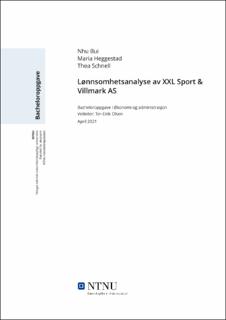| dc.description.abstract | I denne oppgaven har vi tatt for oss den økonomiske utviklingen til XXL Sport & Villmark AS, med hovedfokus på lønnsomheten i perioden 2015-2019. XXL Sport & Villmark AS blir heretter omtalt som XXL. For å svare på problemstillingen har vi tatt utgangspunkt i nøkkeltallene for likviditet, soliditet, finansiering og lønnsomhet. I tillegg har vi gjennomført en strategisk analyse ved å bruke Porters Five Forces. Videre har vi foretatt en enkeltcasestudie, der vi har hentet historiske data fra www.proff.no
Nøkkeltallene for likviditet og finansiering viser at bedriften har hatt en negativ utvikling, samt at nøkkeltallene ikke har vært tilfredsstillende. Lave fordringer, økt gjeld og økte investeringer har bidratt til en svak likviditet og finansiering for bedriften. Videre viser nøkkeltallene for soliditet en positiv utvikling samt en tilfredsstillende soliditet. Når det gjelder lønnsomheten totalt sett kan vi si at bedriften har hatt en god lønnsomhet.
For benchmarking har vi valgt G-Sport/G-Max, som var XXL sin største konkurrent før de ble kjøpt opp av Intersport i 2019. G-Sport/G-Max blir heretter omtalt som G-Max. XXL har beveget seg i riktig retning når det kommer til utviklingen i lønnsomhet. G-Max derimot har beveget seg i motsatt retning, der lønnsomheten har gått ned. Den negative utviklingen forklarer også konkursen til G-Max.
For å supplere lønnsomhetsanalysen har vi utført en strategisk analyse ved bruk av Porters Five Forces. Dette har vi gjort for å få innsikt i årsaker til lønnsomhetsutviklingen til XXL. Årsaken til den positive lønnsomhetsutviklingen skyldes blant annet XXL sine evner til å konkurrere på pris sammenlignet med deres konkurrenter. | |
| dc.description.abstract | In this thesis, we have considered the economic development, with main focus on the profitability of XXL Sport & Villmark AS in the period 2015-2019. XXL Sport & Villmark AS is hereinafter referred to as XXL. To address the problem, we have examined the key figures for liquidity, solvency, financing and profitability. In addition, we conducted a strategic analysis using Porter's Five Forces. Furthermore, we have generated a single case study, and obtained historical data from www.proff.no
The key figures for liquidity and financing show that the company has had a negative development, as well as unsatisfactory key figures. Low receivables, increased debt and increased investments had contributed to weak liquidity and financing for the company. Furthermore, the key figures for solvency show a positive development as well as a satisfactory solvency. When it comes to the overall profitability, we can say that the company has had a good profitability.
For benchmarking, we chose G-Sport/G-Max, which was XXL's biggest competitor before they were acquired by Intersport in 2019. G-Sport/G-Max is hereinafter referred to as G-Max. XXL has moved in the right direction when it comes to the development in profitability. G- Max, on the other hand, has moved in the opposite direction, where profitability has declined. The negative development also explains the bankruptcy of G-Max.
To supplement the profitability analysis, we have performed a strategic analysis using Porter's Five Forces. We have done this to gain insight into the reasons for the profitability development of XXL. The reason for the positive profitability development is partly due to XXL's ability to compete on price compared to their competitors. | |
